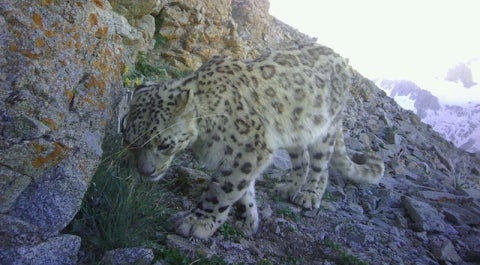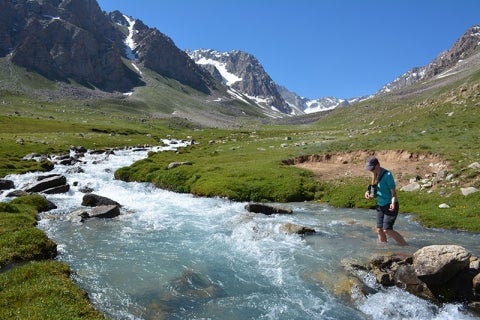Note: Yale School of the Environment (YSE) was formerly known as the Yale School of Forestry & Environmental Studies (F&ES). News articles and events posted prior to July 1, 2020 refer to the School's name at that time.
 A camera trap snapped this photo of a snow leopard in the mountains of western Tajikistan.
A camera trap snapped this photo of a snow leopard in the mountains of western Tajikistan.
A year ago Tara Meyer ’15 M.E.Sc. spent her summer as an F&ES master’s student tracking snow leopards in the mountains of Tajikistan. In a sense though she was looking for a ghost.
Snow leopards are difficult to find even in places where they are known to live. But before last year there was no hard evidence that the elusive cat could even be found in the Hissar Mountains of western Tajikistan, a range known more for extensive livestock grazing and illegal hunting.
During a two-month expedition, however, Meyer and a team of local researchers collected the first scientific evidence confirming that snow leopards live in these mountains. Previously their existence in the range had been only a rumor. Using dozens of motion-activated cameras and DNA technology, they were able to identify a handful of snow leopard individuals. These and other findings from Meyer’s study have revealed the importance of the range as a source of connectivity between two known sub-populations of the cat. Snow leopards are considered critically endangered by the International Union for the Conservation of Nature (IUCN).
Snow leopards are difficult to find even in places where they are known to live. But before last year there was no hard evidence that the elusive cat could even be found in the Hissar Mountains of western Tajikistan, a range known more for extensive livestock grazing and illegal hunting.
During a two-month expedition, however, Meyer and a team of local researchers collected the first scientific evidence confirming that snow leopards live in these mountains. Previously their existence in the range had been only a rumor. Using dozens of motion-activated cameras and DNA technology, they were able to identify a handful of snow leopard individuals. These and other findings from Meyer’s study have revealed the importance of the range as a source of connectivity between two known sub-populations of the cat. Snow leopards are considered critically endangered by the International Union for the Conservation of Nature (IUCN).
 During a two-month expedition, Tara Meyer (left) worked with a team of local researchers to determine whether snow leopards live in the Hissar Mountains of western Tajikistan.
During a two-month expedition, Tara Meyer (left) worked with a team of local researchers to determine whether snow leopards live in the Hissar Mountains of western Tajikistan.
“As we were heading out of the capital of Dushanbe, a lot of people told us, ‘There’s no way you’re going to find snow leopards there,’” Meyer says. “But there were also local people in the foothills who said, ‘Oh, yes, they’re here.’
“We wanted to confirm or deny that as best we could,” she said. “And we were able to verify that yes, this rare species is indeed living in this range.”
The research was done in collaboration with Panthera, a U.S.-based NGO that promotes conservation of the world’s vulnerable big cat populations, and the Institute of Zoology and Parasitology of the Academy of Sciences of Tajikistan.
Only 4,000 to 7,000 snow leopards are believed to exist in the wild across the planet. From the Himalayan mountains in China and Nepal, to eastern Tajikistan, populations of the cat are declining, largely as a result of poaching, livestock grazing, and the loss of wild prey. In Tajikistan, there is a small but robust population of about 400 snow leopards, although most are found in the eastern part of the country, in the Pamir Mountains.
Though the Hissar Mountains may soon be considered critical mountain habitat for the snow leopard, the region has seen a surge in human activity including increased livestock grazing, illegal hunting, deforestation and the seasonal harvest of wild plants and medicinal herbs. Of particular concern is incidences of herders killing snow leopards in retaliation for the loss of their livestock.
To confirm whether any of these elusive cats remain in the region, Meyer and a small team of research assistants hiked dozens of miles across rugged terrain, deploying 40 camera traps and collecting scat samples.
Their cameras were programmed to snap five photos every time something moved in front of it — be it a snow leopard, a marmot, or just plants tossed by the wind. Over six weeks, the cameras snapped more than 32,000 photos; of those, 27 offered glimpses of what turned out to be three individual snow leopards.
“We wanted to confirm or deny that as best we could,” she said. “And we were able to verify that yes, this rare species is indeed living in this range.”
The research was done in collaboration with Panthera, a U.S.-based NGO that promotes conservation of the world’s vulnerable big cat populations, and the Institute of Zoology and Parasitology of the Academy of Sciences of Tajikistan.
Only 4,000 to 7,000 snow leopards are believed to exist in the wild across the planet. From the Himalayan mountains in China and Nepal, to eastern Tajikistan, populations of the cat are declining, largely as a result of poaching, livestock grazing, and the loss of wild prey. In Tajikistan, there is a small but robust population of about 400 snow leopards, although most are found in the eastern part of the country, in the Pamir Mountains.
Though the Hissar Mountains may soon be considered critical mountain habitat for the snow leopard, the region has seen a surge in human activity including increased livestock grazing, illegal hunting, deforestation and the seasonal harvest of wild plants and medicinal herbs. Of particular concern is incidences of herders killing snow leopards in retaliation for the loss of their livestock.
To confirm whether any of these elusive cats remain in the region, Meyer and a small team of research assistants hiked dozens of miles across rugged terrain, deploying 40 camera traps and collecting scat samples.
Their cameras were programmed to snap five photos every time something moved in front of it — be it a snow leopard, a marmot, or just plants tossed by the wind. Over six weeks, the cameras snapped more than 32,000 photos; of those, 27 offered glimpses of what turned out to be three individual snow leopards.
 Meyer hiked dozens of miles across rugged terrain, deploying 40 camera traps — and then retrieiving them a few weeks later.
Meyer hiked dozens of miles across rugged terrain, deploying 40 camera traps — and then retrieiving them a few weeks later.
DNA analyses of scat samples collected during the fieldwork confirmed the presence of at least two additional snow leopards in the study area. “It’s safe to say that there are at least five different snow leopards in our study area,” Meyer said.
Meyer and her team also identified Siberian ibex, red marmot, Himalayan brown bear, Himalayan snowcock, red fox, one weasel and one bat species. Furthermore, DNA tests confirmed the presence of lynx. Before this study, the status of all these species in the Hissar range was unknown or undocumented.
In the case of the snow leopards, their documented presence in the Hissar Mountains justifies the need for improved wildlife and livestock management in the area and supports the need for local action to ensure the long-term conservation of this elusive and endangered cat, Meyer said.
“We saw in this study that snow leopards can live in the same places where people are using the land and living on the land,” Meyer said. “This implies to me that it’s possible to have co-existence between people and this elusive predator.
“One of the hopeful findings we got from our interviews and surveys was that there doesn’t seem to be a high level of conflict between people and snow leopards in this area for whatever reason. To me that means that it’s possible for people to use the landscape, to graze their livestock, to search for firewood and medicinal supplements in the same landscapes where these endangered snow leopards are living.
“But the changes over the past 20 years also indicate that achieving this coexistence requires a fine balance. While there’s a potential for both to be on the same landscape, there’s also an important message of proper livestock management and regulation of hunting and the importance of not over-using these natural resources.”
The research was funded by The Schiff Fund for Wildlife, Habitat and Environment; Panthera; Carpenter Sperry; the F&ES Summer Fund; and the F&ES-based Tropical Resources Institute.
Meyer and her team also identified Siberian ibex, red marmot, Himalayan brown bear, Himalayan snowcock, red fox, one weasel and one bat species. Furthermore, DNA tests confirmed the presence of lynx. Before this study, the status of all these species in the Hissar range was unknown or undocumented.
In the case of the snow leopards, their documented presence in the Hissar Mountains justifies the need for improved wildlife and livestock management in the area and supports the need for local action to ensure the long-term conservation of this elusive and endangered cat, Meyer said.
“We saw in this study that snow leopards can live in the same places where people are using the land and living on the land,” Meyer said. “This implies to me that it’s possible to have co-existence between people and this elusive predator.
“One of the hopeful findings we got from our interviews and surveys was that there doesn’t seem to be a high level of conflict between people and snow leopards in this area for whatever reason. To me that means that it’s possible for people to use the landscape, to graze their livestock, to search for firewood and medicinal supplements in the same landscapes where these endangered snow leopards are living.
“But the changes over the past 20 years also indicate that achieving this coexistence requires a fine balance. While there’s a potential for both to be on the same landscape, there’s also an important message of proper livestock management and regulation of hunting and the importance of not over-using these natural resources.”
The research was funded by The Schiff Fund for Wildlife, Habitat and Environment; Panthera; Carpenter Sperry; the F&ES Summer Fund; and the F&ES-based Tropical Resources Institute.
– Kevin Dennehy kevin.dennehy@yale.edu 203 436-4842

Published
July 6, 2015